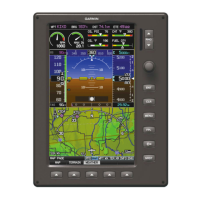190-01115-01 G3X™/G3X Touch™ Avionics Installation Manual
Rev. AV Page 19-7
19.6 Mounting Considerations
The GTR 20 is designed to mount remotely.
19.6.1 Bracket Installation
The GTR 20 is shipped with the brackets positioned on the ends of the unit. The brackets can be removed
from the bottom of the GTR 20 and repositioned by the installer. The GTR 20 mounting brackets can be
positioned on the sides or the ends of the GTR 20. The installer determines the orientation and position of
the brackets that best suits the installation. See Figure 19-2
and Figure 19-3 for bracket positions.
19.6.2 Unit Mounting
Secure the GTR 20 to the airframe in a suitable mounting location using a minimum of four #10 fasteners
(not provided). Hardware is intended to be located in the 4 outermost mounting locations. The center
locations in each bracket are additional locations provided for the installer’s convenience.
Do not mount the GTR 20 on the “hot” side (engine side) of the firewall. To reduce interference, route the
GTR 20 wiring harness separately from any COM radio or transponder antenna coax.
No cooling air is required for the GTR 20/200, however, as with all electronic equipment, lower operating
temperatures extends equipment life. Reducing the operating temperature by 15° to 20°C (27° to 36°F)
reduces the mean time between failures (MTBF).
For final installation and assembly, see Figure 19-2
, Figure 19-3, and Figure 19-4.
19.6.3 Antenna Installation and Connections
The GTR 20 requires a standard 50 vertically polarized antenna. Follow the antenna manufacturer’s
installation instructions for mounting the antenna.
The antenna should be mounted on a metal surface or a ground plane with a minimum area of 18 inches x
18 inches. Refer to Section 19.5.1
for installation location considerations.
19.6.4 Antenna Coaxial Cable Installation
The antenna coax cable should be made of RG-142B, RG-400 or a comparable quality 50 coax. See
Section 2.4
or follow the BNC connector manufacturer’s instructions for cable preparation/connector
installation.
Check there is ample space for the cabling and mating connectors. Avoid sharp bends in the antenna cable,
and routing near aircraft control cables. Route the COM antenna cable as far as possible away from any
GPS antenna cables.
Check for insertion loss and Voltage Standing Wave Ratio (VSWR). VSWR should be checked with an in-
line type VSWR/wattmeter inserted in the coaxial transmission line between the transceiver and the
antenna. The VSWR meter should be inserted as close to the transceiver as possible. When rack and
harness buildup is performed in the shop, the coax termination may be provisioned by using a 6-inch in-
line BNC connection. This would be an acceptable place to insert the VSWR meter. Any problem with the
antenna installation is most likely seen as high reflected power. A VSWR of 3:1 may result in up to a 50%
loss in transmit power. VSWR at the low, mid and high end of the tuning range should be less than 3:1, for
best performance VSWR should be less than 2:1. A high VSWR decreases the amount of power radiated
by the antenna and increases power supply current and heat dissipated by the radio when the radio is
transmitting.

